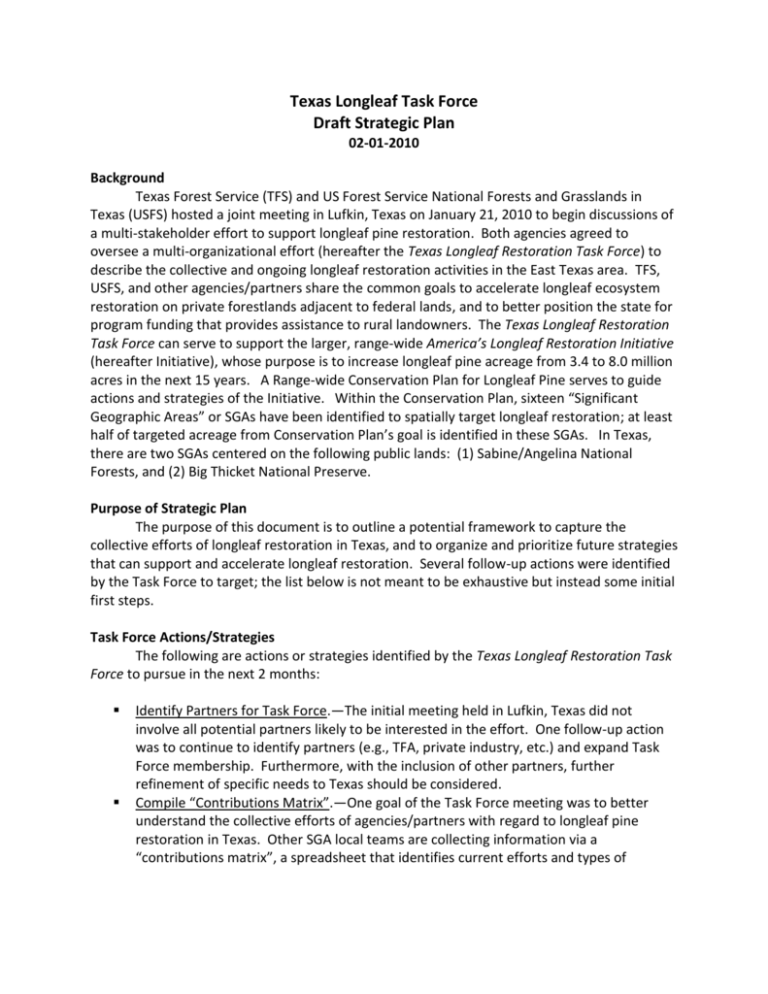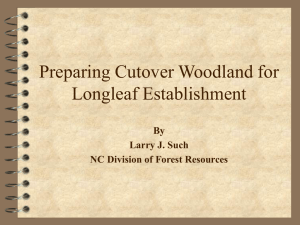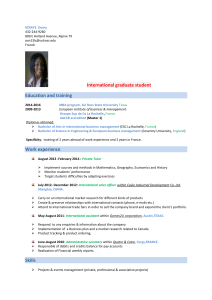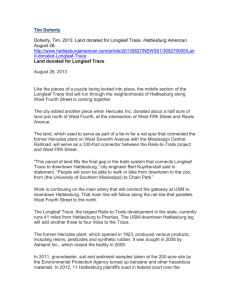Texas Longleaf Task Force Draft Strategic Plan - Texas
advertisement

Texas Longleaf Task Force Draft Strategic Plan 02-01-2010 Background Texas Forest Service (TFS) and US Forest Service National Forests and Grasslands in Texas (USFS) hosted a joint meeting in Lufkin, Texas on January 21, 2010 to begin discussions of a multi-stakeholder effort to support longleaf pine restoration. Both agencies agreed to oversee a multi-organizational effort (hereafter the Texas Longleaf Restoration Task Force) to describe the collective and ongoing longleaf restoration activities in the East Texas area. TFS, USFS, and other agencies/partners share the common goals to accelerate longleaf ecosystem restoration on private forestlands adjacent to federal lands, and to better position the state for program funding that provides assistance to rural landowners. The Texas Longleaf Restoration Task Force can serve to support the larger, range-wide America’s Longleaf Restoration Initiative (hereafter Initiative), whose purpose is to increase longleaf pine acreage from 3.4 to 8.0 million acres in the next 15 years. A Range-wide Conservation Plan for Longleaf Pine serves to guide actions and strategies of the Initiative. Within the Conservation Plan, sixteen “Significant Geographic Areas” or SGAs have been identified to spatially target longleaf restoration; at least half of targeted acreage from Conservation Plan’s goal is identified in these SGAs. In Texas, there are two SGAs centered on the following public lands: (1) Sabine/Angelina National Forests, and (2) Big Thicket National Preserve. Purpose of Strategic Plan The purpose of this document is to outline a potential framework to capture the collective efforts of longleaf restoration in Texas, and to organize and prioritize future strategies that can support and accelerate longleaf restoration. Several follow-up actions were identified by the Task Force to target; the list below is not meant to be exhaustive but instead some initial first steps. Task Force Actions/Strategies The following are actions or strategies identified by the Texas Longleaf Restoration Task Force to pursue in the next 2 months: Identify Partners for Task Force.—The initial meeting held in Lufkin, Texas did not involve all potential partners likely to be interested in the effort. One follow-up action was to continue to identify partners (e.g., TFA, private industry, etc.) and expand Task Force membership. Furthermore, with the inclusion of other partners, further refinement of specific needs to Texas should be considered. Compile “Contributions Matrix”.—One goal of the Task Force meeting was to better understand the collective efforts of agencies/partners with regard to longleaf pine restoration in Texas. Other SGA local teams are collecting information via a “contributions matrix”, a spreadsheet that identifies current efforts and types of management practices being implemented. A modified version of the contributions matrix will be used to compile the collective efforts of Texas agencies/partners. Priorities Target Areas.—Establish mapping team to identify overlapping “mission” interests and serve to prioritize and target “areas of opportunities”. The mapping team will compile and present information to the Task Force to facilitate informed management decisions. Host Landowner Tour.—Education and outreach with private landowners will determine the overall success of the Initiative and Task Force. An initial education and outreach strategy was to host a landowner tour to review practices and challenges in longleaf restoration in East Texas. Elevate Awareness of Texas Efforts.—Efforts by the Task Force can serve to support range-wide efforts of America’s Longleaf. Conversely, elevating the awareness of Texas efforts to leadership of the Initiative and Longleaf Alliance also can serve to facilitate support at a regional/national level. The Task Force will continue to maintain contacts with these key organizations. Collectively, the above actions can provide the basis for developing a longleaf strategic plan in East Texas and possibly Louisiana (could be a multi-state effort). The Task Force will explore steps to develop such a plan to include the following key elements: Seed Sources.—Identification of seed sources and related materials are a limiting factor in longleaf restoration. Overcoming these logistical challenges will need to be addressed in order to be successful. Technical Assistance.—Approximately 66% of lands in East Texas are privately-owned. Thus, longleaf restoration success will largely be dependent on technical assistance and resources needed by private landowners. Landowner incentives will play a fundamental role in the longleaf restoration effort, and possible funding sources and strategies need to be identified. Funding Support.—Pathways to facilitate the rapid transfer of funds to landowners and supporting programs will need to be identified and/or put in place. Existing state and federal programs should be evaluated as to their capacity to serve as a mechanism to deliver support to landowners for longleaf restoration. In addition, identification of the various potential and appropriate funding sources also needs to be identified. Organizational Structure.—Continued communication and evaluation of the state strategic plan will periodically need to be updated or revisited. Initially, TFS & USFS will provide coordination and oversight support for the Task Force. A plan to maintain support of the Task Force in the future should be considered. For more information, feel free to contact Jan Davis, TFS jdavis@tfs.tamu.edu or Kent Evans, USFS kevans@fs.fed.us.









